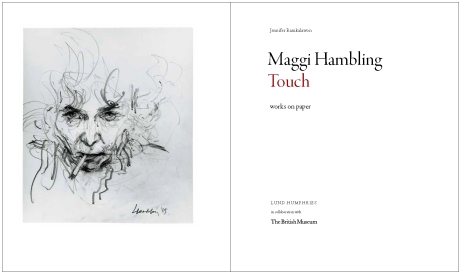Maggi Hambling: Touch
In September 2016 Lund Humphries publishes the first book to focus on the drawings and prints of one of Britain’s foremost figurative artists. Maggi Hambling: Touch, by Jennifer Ramkalawon accompanies an exhibition of Hambling’s works on paper at the British Museum (8 September 2016 to 29 January 2017). Read the opening of the book and view a preview of its pages below.
What is this drawing? Not once in describing the shape of that mass did I shift my eyes from the model. Why? Because I wanted to be sure that nothing evaded my grasp of it … my objective is to test to what extent my hands already feel what my eyes see. AUGUSTE RODIN
A draftsman cannot but be attentive to the finger and the eye, especially to anything that touches upon the eye, to anything that lays a finger on it in order to let it finally see or let it be seen [donner à voir]. JACQUES DERRIDA
Her fingers touching the paper with a stick of charcoal or graphite pencil or rubber. Yet is that all they are doing? Are they not touching the face too, the face, the nose, the hair, the eyes – so that they shut a little, the corners of the mouth? What is the relation between tracing and stroking, between an erasure and a caress? JOHN BERGER
MARK MAKING: TOUCHING THE SUBJECT
Artist, philosopher and critic all understand the emotional impact of touch for a Draughtsman. For Rodin it is the physicality between him and his subject. For Derrida, touch manifests itself through the eyes of the artist and then is relayed to the finger to produce the work. Berger is more literal: for him this notion lies with the artist physically touching the paper in order to draw the subject through ‘stroking’ and a ‘caress’. Rodin Was clear that mark making for him in the form of drawing, was an intense and vital part of his artistic practice. Equally for Maggi Hambling, drawing has always formed the central core of her work. Like Rodin, through the act of mark making Hambling reveals the elusive qualities of her subjects through the senses of sight and touch, saying: ‘Drawing is an artist’s most direct and intimate response to the world. The touch of charcoal, graphite or ink on paper is full of endless possibilities. I try to distil the essence of a subject and capture the life-force of a moment. The challenge is to touch the subject with all the desire of a lover.’4 For Hambling, this expressive and sensual concept of ‘touch’ derives from a deep connection with the subject being drawn, through fluid graphite lines, forceful strokes of charcoal or delicate ink wash.
Buy Maggi Hambling: Touch: works on paper here from our site





